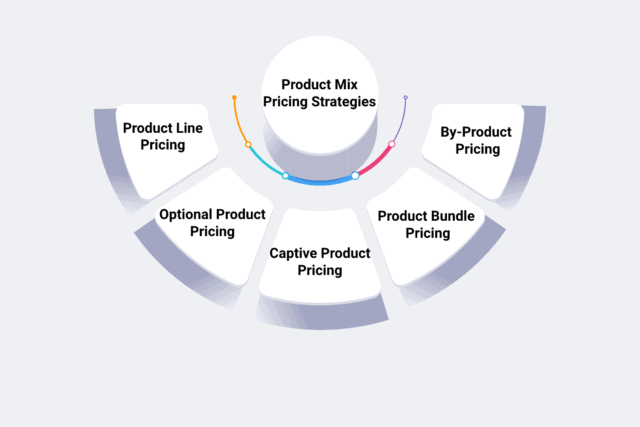Even the best suitable product with world-class marketing tactics can only make good sales with the utilized product mix pricing strategies. Therefore, pricing is one of the most significant factors in the buyer’s decision.
It affects the company’s revenue, profit, and overall profile. Even the McKinsey report revealed that a 1% price increment could boost the profit margins up to 8%. However, if a company is inconsistent in its pricing decision, it becomes a legit issue for the growth of the company.
This guide contains everything you need to know about Product Mix Pricing Strategies. Let’s begin with understanding what pricing strategies are!!
What is Product Mix Pricing?
Pricing mix (or marketing mix price) is one of the most balanced combinations of “price-related variables” depending upon the products and services offered by the company. Such variables include product-making cost, influential factors for pricing decisions, pricing objectives, promotional pricing and much more.
In simple terms, Price refers to the amount of money a customer has to pay to purchase the product. Thus, it can be called the product’s or service’s economic value.

The right price always helps the companies to achieve their financial objectives, adapt to the market situation, and conform to the other elements of the marketing mix, such as quality of product, distribution issues, and promotional challenges.
Product mix basically specifies the product’s future and acceptance among customers and works as a weapon for the competitors. Therefore, you should decide on pricing more wisely, as it is the only marketing mix element that can generate revenue while others create the cost.
Why Are Product Mix Pricing Strategies Important?
You would have seen that products in the same product mix generally have similar pricing. But, have you ever thought, why is it so?
Simply, you always need to set up the price of any product considering the entire marketing mix product. It will allow you to maximize profit over the total product mix rather than only the single effect. However, setting up the price for one product without considering another product mix can create problems.
It may not allow you to maximize the profit or affect the sales of other products. For example, if you have priced a high-end car too low, there are two issues. Firstly, its profit is less. Secondly, it will also impact the sales of other products. Thus, having an overall approach to all five product mix pricing strategies is essential.
However, many companies must pay more attention to price adjustment strategies. But, it is an essential part of setting up any strategy. If you look at the other brands in the market, you will realize how widely product mix pricing strategies are implemented.
5 Product Mix Pricing Strategies
For any marketing mix product, companies generally opt any of the product mix pricing strategies, which are as follows:

1. Product Line Pricing
In product line pricing, companies must set the price for the entire product line. For example, you may have seen various series of Cars and their price difference based on the model.
Most companies are more interested in product line pricing instead in launching a single product. Because it provides better features and price comparisons for the customers. At the same time, it is also more beneficial for the companies.
2. Optional Product Pricing
In optional product pricing, organizations combine an optional product with the main product. For example, you can purchase an optional ice maker with a refrigerator or optional alloys with the car.
Organizations intentionally separate some optional products from the main ones to avoid making customers feel that products are costly. It also benefits the organizations through extra sales of other products.
3. Captive Product Pricing
Captive product pricing refers to setting prices for two different products simultaneously. However, one is used as the main product while the other is used with the main product. For example, Gillette’s razor with its blades and Cameras with films.
Here, companies sell the main product at a low price while they earn with the recurring products, including cartridges for razors and films for cameras.
4. By-Product Pricing
By-Products are often produced with the main products. And, In By-Product pricing, organizations set up the prices for the by-products to increase the competitiveness of the main product’s price and reduce the additional cost of disposing of the by-products.
It also helps the companies to find a separate market to sell these by-products. Often, by-products sell at a reasonable price and make a significant profit for your company.
5. Product Bundle Pricing
Product Bundle Pricing is one of the most prominent strategies these days. Organizations sell various products together in the Product Bundle Pricing after forming them as a bundle. For example, at a reasonable price, you may have seen a bundle of a burger, fries, and soft drinks in Mcdonald’s.
These bundles benefit the customers and the organizations by selling more products at a time. It simply encourages customers to purchase more products instead of a single product.
Product Mix Pricing Strategies Example
We have mentioned some of the real-life examples of product mix pricing strategies below to help you better understand the concept:
Example – 1
Uniqlo, a Japanese clothing brand, is one of the best examples of product mix pricing strategies examples. Because every product comes at a reasonable price aiming to increase the market share with a sales-oriented approach plus, this brand prefers producing quality over quantity, and thus it is leading the industry.
Example – 2
Dove is also the best product mix pricing example. It has its primary focus on providing quality. Dove even sells two packs of Dove Beauty Moisture Body Wash at $1.10 less than the actual price. This is called the bundle pricing strategy.
Final Verdict
This is the complete guide to Product Mix Pricing Strategies. It consists of all the factors regarding the best implementation of pricing strategies for the organization. You can even implement all these factors. We hope you like this guide and that it covers everything you want.
Frequently Asked Questions (FAQs)
What are 5 product mix pricing strategies?
These are the 5 product mix pricing strategies:
- Product Line Pricing
- Optional Product Pricing
- Captive Product Pricing
- By-Product Pricing
- Product Bundle Pricing
What is a product mix pricing strategy?
Product mix pricing strategy considers pricing an essential factor in the marketing mix. It helps organizations maximize profit, market share, and organizational growth.
What is product mix strategy?
A suitable product mix strategy refers to putting efforts and resources into your product and product line to boost a company’s revenue, growth, and market share.
What are the 7 pricing factors of the product?
These are the 7 essential factors you need to consider before pricing any product:
- Define the target market of your product
- Analyze your targeted customer’s habit
- Keep your product/service valuable and
- Do not waste time just competing with everyone
- Justify your piercing to your customers through your product offering
- Do not go for the higher profit margins at the starting
- Have your focus more on quality and credibility
Why is product mix pricing important?
Product mix pricing is essential because it helps achieve various factors for the organization. It includes the profitability of an organization and product positioning support and complements the marketing mix.